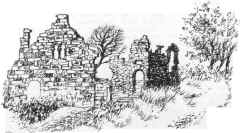 Hunton Manor
Hunton Manor
Culpepper Connection
Fairfax Harrison: "It is
significant that in all these testimonies William Culpeper10
appears only in relation to Kent. In his grant of the priory of
Lossenham he is, indeed, described as 'of Hunton,' while
his second son was listed at Winchester College in 1553 (Kirby, Winchester
Scholars, 1888, p. 132) by the same qualification. Thus it
appears that on his marriage, which took place in 1530 as appears
from the record of the family settlement of that year, William10
established himself, not at Wigsell, but in the midst of the
Kentish weald, on the river Beult near its junction with the
Medway. This was an eminently agreeable place of residence, but
Hunton was not a Culpeper lordship. It was vested in the Wyatts of
Allington (Hasted, ii, 229), a family which, like the Culpepers,
later produced a Governor of Virginia.".
Hunton Manor History
After the Conquest, the Lords of the Manor of Hunton were the monks
of Christ Church Priory, Canterbury. Possession subsequently passed to
mediaeval barons. The de Lenhams held Hunton, and in Henry III's reign
took over the adjacent manor from John de Bensted. Later the family
lacked a male heir; ownership passed to another prosperous family - de
Clinton.
After the Reformation Hunton Court was given to Sir Thomas Wyatt,
knighted and made High Sheriff of Kent by Henry VIII. (Sir Thomas
apparently leased the manor to William Culpeper as mentioned by
Fairfax Harrison, above.).
Sir Thomas Wyatt, junior, led a rebellion of Kentish men against
Queen Mary. Mary had succeeded her half-brother, Edward Vl, when he
died at the age of 16. She was a Roman Catholic, sought to
re-establish the Pope's authority in England, and chose to marry
Philip, the Roman Catholic King of Spain. While many Englishmen were
as willing to accept changes in religion as later they accepted
changes in government, others were not. Danger of subservience to a
foreign power, along with fear for their property (given to them on
the dissolution of the monasteries), was too much for some squires,
young Thomas among them. His rebellion failed. He was executed, and
his estates forfeited to the crown. Elizabeth granted Hunton Court to
Sir John Baker, of Sissinghurst. (See the Wyatt
family web site for more details on Wyatt's Rebellion).
 Land-owners
often held a number of estates, and may have neglected some, or put in
irresponsible tenants. Details of what happened are lacking, but the
historian Hasted, writing towards the end of the 18th century, records
that "the whole seat called Court-Lodge, near the church, has
long been ruinated; but the site of it, as well as the moat which
surrounded it, are still visible".
Land-owners
often held a number of estates, and may have neglected some, or put in
irresponsible tenants. Details of what happened are lacking, but the
historian Hasted, writing towards the end of the 18th century, records
that "the whole seat called Court-Lodge, near the church, has
long been ruinated; but the site of it, as well as the moat which
surrounded it, are still visible".
Evidently the present house was built soon after Hasted wrote.
Ownership lay with a yeoman farmer named Turner. The house we see
today, known as Hunton Court, is a ragstone building of the late 18th
century, with alterations and additions, (e.g. bow windows and
balustrades) of about 1850. Built on the site of earlier houses, it
includes a 13th century stone undercroft, and vestiges of Tudor work.
There are some 150 acres of garden and park, which include Forge
Field, between Hunton Hill and East Street. The lakes cover over two
acres; they may follow the lines of a mediaeval mote. They are fed by
a stream from the hills which passes near Gennings.
At the close of the 19th century, Hunton Court was the country home
of Sir Henry Campbell-Bannerman, Liberal Prime Minister from 1905-08.
Sir Henry inherited the property not from his father, Sir James
Campbell, who lived at Strachathro in Scotland; but from his mother's
brother, Henry Bannerman, who also owned Gennings. The hyphenated
surname arose because in his will Henry Bannerman made it a condition
of his nephew's inheriting his property that he adopted too the name
of Bannerman. Sir Henry and Lady Campbell-Bannerman left no issue. The
present owner is a great nephew of the Prime Minister.
Writing in 1938, Mr. J. Bartholomew reminisced: "As a choirboy
1 can remember the filing into church of Mr. Henry Campbell-Bannerman
and his fellow members of Gladstone's cabinet, Hughie Childres, Robert
Lowe etc." This would have been about 1873.
Source: Desmond Morey, Hunton:
A Kentish Village, a pamphlet of uncertain date, but after
1987 and before 2000, published by St. Mary's Church, Hunton,
pages 10-11.
Hunton Court Location: A
few hundred yards south of
the church
National Grid Coordinates: TQ
726 496.